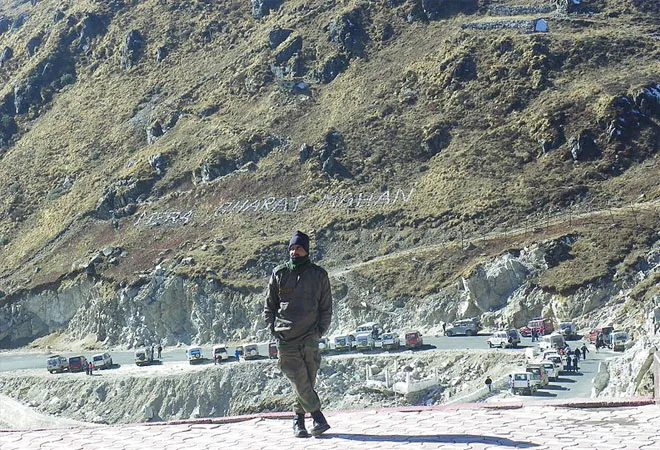The June 2020 clashes in Galwan marked a major inflection point in China-India relations that continue to loom over evolving dynamics between the two nations. In the years since, Indian officials have given stern assessments on bilateral ties. On the sidelines of a G20 meeting in March 2023, Indian Foreign Minister S. Jaishankar told his Chinese counterpart, Qin Gang, that relations between the two nations were “
abnormal.” A month later, Indian Defense Minister Rajnath Singh said China’s actions on the border “
violated the basis” of relations between the two nations. While the level of violence witnessed in the Galwan clashes has not returned, China tried to “unilaterally alter the status quo” in the Tawang region in Arunachal Pradesh along the eastern section of the LAC in December 2022.
The deterioration of ties was hard to imagine a few years ago. Between 2014 and 2019, Prime Minister Modi engaged with Xi Jinping on
18 occasions with the goal of strengthening communication between the two militaries, in order to avoid a standoff like the one between the Indian Army and the PLA in Dokhlam in 2017. Furthermore, the Wuhan Summit in 2018, billed as a “
reset” in ties, built belief that healthy trade and investment ties could act as a catalyst in resolving political disputes. In 2019, PM Modi invited Xi for an informal summit at
Mamallapuram, Tamil Nadu, where the two leaders resolved to improve commercial exchanges and set up a manufacturing partnership.
The Wuhan Summit in 2018, billed as a “reset” in ties, built belief that healthy trade and investment ties could act as a catalyst in resolving political disputes.
However, from India’s perspective, earnest efforts to engage with China were met with a stab in the back in the Galwan valley in 2020. Now, relations between the two Asian powers face a precipice with no safety net in sight.
Refining the Art of War: Chinese Internal Developments
Chinese President Xi Jinping has served at the helm of the Central Military Commission (CMC), a body that oversees the People’s Liberation Army, for over a decade. During his leadership, Xi has modernized the hardware and software of war, boosting the PLA’s readiness. In addition to
restructuring the army units and reconstituting command theaters, China has made forays into new fronts such as space and cyberspace with the constitution of the
Strategic Support Force. The PLA has also adapted its recruitment strategy to target university students with degrees in engineering, communications, and drone operations. The PLA’s transformation is marching in step with China’s aggression and expansion on multiple fronts, as seen in the declaration of an Air Defense Identification Zone over the East China Sea, reclamation of South China Sea islands, and heightened aggression and infrastructure buildup along the Line of Actual Control with India.
Xi also directed the PLA and the People’s Armed Police (PAP) to formulate integrated strategies and create a
reserve force to protect national security. In 2022, the
Land Border Law came into force that sought to leverage civilians for improving border security. It also emphasized the need to resettle populations, upgrade critical infrastructure along the India-China border, and improve political education to consolidate a sense of community and allegiance to the Chinese nation.
Xi also directed the PLA and the People’s Armed Police (PAP) to formulate integrated strategies and create a reserve force to protect national security.
At the same time, China’s internal troubles may also encourage external adventurism, which helps a ruler consolidate power. Xi faces a slowing economy and a rising tide of unemployment that touched
20.8 percent in May for the 16-24 age bracket. To signal strength and ward off any internal challenges to his position, Xi may seek military adventurism. As a reminder, Mao’s followed his disastrous ‘Great Leap Forward’ campaign with an aggressive posture towards India that culminated in the 1962 war. In China, domestic politics reign supreme and will continue to cast a shadow on bilateral relations with India.
Race for Himalayan Infrastructure Upgrade
In 2023, China’s
defense budget reached USD $225 billion, enabling Xi to build infrastructure along the India-China border to support the PLA’s deployment and prolong its staying power. Along with expanding living quarters for its troops near the border, China recently pledged to begin work on a new railway line connecting
Xinjiang and Tibet, that will run close to the LAC and cut through the Chinese-administered Aksai Chin region that India claims. China is planning to pave another arterial route connecting
Xinjiang and Tibet, again through Aksai Chin, which would improve its ability to deploy troops and bring in reinforcements.
The Indian government is watching China’s infrastructure development scheme along the border. In 2013, India’s then
Defense Minister commended the facilities as being better than India’s. Conventionally, New Delhi has refrained from developing critical facilities along the border to avoid aggravating tensions on the LAC and prompt an attack.
Recent years have witnessed an evolution in Indian strategic thinking regarding infrastructure development along the border. Indian strategists believe that building up infrastructure on the Indian side will help in troop mobilization. In Ladakh alone, the Border Roads Organization is planning to finish
54projects in 2023, chiefly constructing motorways and bridges. The agency had accomplished
45 similar projects in the region in 2021 and 2022. Under the ‘
Vibrant Villages Program’, nearly 3,000 villages along the India-China border are set to get better roads, power projects, and mobile-phone connectivity.
China is planning to pave another arterial route connecting Xinjiang and Tibet, again through Aksai Chin, which would improve its ability to deploy troops and bring in reinforcements.
This initiative to improve infrastructure along the border comes close on the heels of China
renaming areas in India’s Northeast state, Arunachal Pradesh, which the People’s Republic
claims is a part of Tibet. The years to come will show if improving quality of life in these areas will persuade Indian residents to remain in the border areas instead of migrating to the hinterland, and enhance India’s border security and territorial integrity.
India Ramps up in Response
China’s belligerence at the border coupled with its and a massive build-up of infrastructure speaks volumes of its capabilities, to which India has responded in several ways. Since the 2020 Galwan clashes, New Delhi has boosted troop deployments and enhanced operational logistics in Ladakh. Mechanized and armored regiments have increased from around 5 to
12, and advanced equipment for surveillance and reconnaissance has increased along with living quarters, military posts, and gun positions.
India has also responded with a major restructuring of the decision making bodies within the Indian Army. In 2019, the Modi government announced its decision to institute the
Chief of Defense Staff (CDS) with the specific intention of modernizing the armed forces. Along with that, the
Department of Military Affairs was created to facilitate better inter-services integration and civil-military coordination. Nearly four years after these important changes were instituted, a
theater command structure is finally getting off the ground. With theater commands, different branches of the military operate under a unified command structure that synergizes combat capabilities to enhance warfighting capabilities, particularly in the face of a reenergized Chinese threat.
Scholars argue that with Russia and China moving closer together, this may pose a challenge to India in the eventuality of a conflict with Beijing. Moreover, with these challenges mounting in the national security arena, the Modi government is working to build an indigenous defense industrial base. Data from the Stockholm International Peace Research Institute shows that
India was among the world’s largest importers of armaments between 2018 and 2022, and India’s current defense engagement lays emphasis on joint production and technology transfer.
With theater commands, different branches of the military operate under a unified command structure that synergizes combat capabilities to enhance warfighting capabilities, particularly in the face of a reenergized Chinese threat.
India has deepened its defense cooperation with nations like the United States and France to combat China on its border and in the Indo-Pacific. Close on the heels of India signing an agreement with General Electric Aerospace to develop engines for combat aircraft with
80 percent technology transfer, India has sealed a deal with France on the co-developing of
engines for warplanes and helicopters. Ahead of Prime Minister Narendra Modi’s trip to France, India cleared the decks for the purchase of an additional
26 Rafale aircrafts and three
Scorpene-class submarines. These developments will make it more difficult for China to maintain its dominance in the Indo-Pacific region.
In Modi’s speech to the joint sitting of the U.S. Congress in June, two major themes pointed to the trajectory of how India will take on the China challenge. One, he raised the specter of “dark clouds of
coercion and confrontation,” pitching for a free, open, and inclusive Indo-Pacific. Two, he made a case for India’s place in the international order in partnership with the United States. This makes it clear that China is the driving force that has brought the United States and India together.
Having shed “
hesitations of history”, to cement defense cooperation with the United States by inking four foundational agreements on military information, logistics, compatibility, and security, India is looking to take this relationship to the next level. Peruse the arenas of India-U.S. cooperation: semiconductor production, space exploration, and the deal to jointly manufacture jet engines. India seeks to build its technological arsenal with American expertise in its endeavor to combat the China challenge. The tech foundation is also being consolidated by the indigenization of military hardware, and greater involvement of the private sector in building these capabilities. The first India-manufactured C295 military transport aircraft is all set to take flight by 2026.
For the first time in decades, India’s economy is showing more promise and potential than China’s. The Asia Development Bank contrasts India’s GDP growth in FY2024 at
6.7 percent with China’s at
4.5 percent. There is greater political stability in India that has resulted in military modernization, and engagement with strong partners like the United States and France. It may be too early to draw conclusions based on these metrics, but India has shown that it has the ability to prepare for the long haul to take on China.
This commentary originally appeared in South Asian Voices.
The views expressed above belong to the author(s). ORF research and analyses now available on Telegram! Click here to access our curated content — blogs, longforms and interviews.




 PREV
PREV


